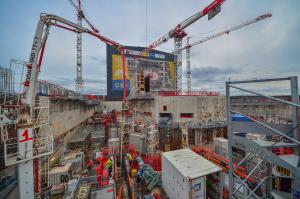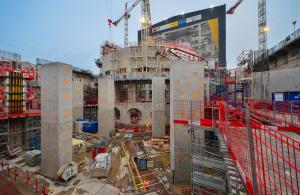Tokamak building
The undressing of the bioshield
5 Feb 2018
-
R.A.
More than two years ago in October 2015, concrete pouring began for one of the most striking structures of the entire construction site: the ITER bioshield, a massive cylindrical fortress that surrounds the machine and protects workers and the environment from the radiation generated by fusion reactions.
As formwork was removed from the bioshield proper, new moulds and scaffolding were being erected on the north side of the structure. They are for the reinforced wall that will support the 10-metre-high "vault" that will accommodate equipment for the Tokamak's cooling water system (TCWS).
The massive structure of the bioshield—an emblem of the ITER Project—is now bare and its revealed anatomy helps us to better understand its function.
As construction progressed, the nest-like structure became the defining feature of Tokamak Complex construction and an icon for the project as a whole. Pictures of the bioshield—taken from above in the slanted late evening light by drone or from a crane—have been a favourite of the media for the past two years.
Until last week, however, what was visible of the bioshield was mostly ... the formwork that surrounded it—white and red moulds, scaffolding and platforms pressing against grey concrete and brown rebar.
Now, the bioshield is fully formed and this equipment is not needed anymore. The structure is bare and its anatomy, now revealed, helps us better understand its function—how, for instance, penetrations of all sizes and shapes will allow neutral beam injectors, diagnostic systems and remote handling machinery to reach the heart of the machine.
Covered or naked, the fortress remains imposing—a renewed emblem for a unique project.



